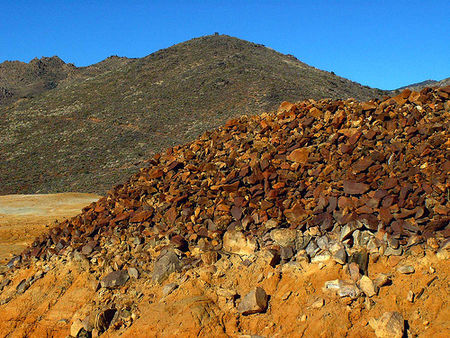Micromining: Difference between revisions
m (fixed internal links) |
|||
| Line 23: | Line 23: | ||
* for metallurgy, use of [[induction furnace]] and [[digital fabrication]] are major improvements | * for metallurgy, use of [[induction furnace]] and [[digital fabrication]] are major improvements | ||
* advanced techniques for [http://en.wikipedia.org/wiki/Underground_mine_ventilation underground mine ventilation] (e.g. using solar thermal or wind energy) | * advanced techniques for [http://en.wikipedia.org/wiki/Underground_mine_ventilation underground mine ventilation] (e.g. using solar thermal or wind energy) | ||
* use of open source [[aerial Ropeways]] to transport large amounts of earth/rock | * use of open source [[aerial Ropeways|aerial ropeways]] to transport large amounts of earth/rock | ||
* low-level geothermal heat is major problem in traditional underground mining. Could be used for space heating in the future (greenhouses; use heat exchanger if mine exhaust is somehow toxic). | * low-level geothermal heat is major problem in traditional underground mining. Could be used for space heating in the future (greenhouses; use heat exchanger if mine exhaust is somehow toxic). | ||
==Product Ecology== | ==Product Ecology== | ||
* use of versatile agricultural equipment such as [[LifeTrac]] and [[Well Drilling Rig]] | * use of versatile agricultural equipment such as [[LifeTrac]] and [[Well Drilling Rig|well drilling rig]] | ||
* mining of [[aluminum from clay]] using using hydrofluoric acid solution | * mining of [[aluminum from clay]] using using hydrofluoric acid solution | ||
* mining of copper with sulfuric acid (see: [[biomining]]) | * mining of copper with sulfuric acid (see: [[biomining]]) | ||
* use of [[biogas]] and syngas for carbothermal reduction of iron (see [[Metal Refining]]) | * use of [[biogas]] and syngas for carbothermal reduction of iron (see [[Metal Refining| metal refining]]) | ||
* novel biotechnology methods (see [[biomining]]) | * novel biotechnology methods (see [[biomining]]) | ||
* for underground mining: use of thermal ventilation or [[compressed Air]] | * for underground mining: use of thermal ventilation or [[compressed Air|compressed air]] | ||
==Related pages on OSE wiki== | ==Related pages on OSE wiki== | ||
Revision as of 03:30, 6 February 2011
The earth's crust is full of small mineral deposits but their recovery may not be economic under the current system. Small-scale or "micro" mining ("artisanal mining") can extract wealth from small mineral deposits that might not be worthwhile to exploit by traditional large-scale mining processes. Despite smaller size, these deposits may still allow for high-margin operations. Small communities may profitably mine these reserves, although this requires a different mind-set. Communities can use low-tech excavation techniques, down to pick and shovel. Even if the infrastructure is more advanced, it does not have to be purchased and can possibly be built by the community itself, drastically cutting up-front investment requirements. Some recent advances in mining technology, such as biomining and cheap sensors can easily be scaled down.
Some principles for community based micro-mining
- use machines that can be built from simple parts, are easy to use and repair
- minimize amount of material that is moved to the surface, try to process in situ and only transport the finished product
- minimize energy requirements per cubic meter, use free energy that may be available (solar, hydro, biomass; other "stranded" energy)
- slow but steady mining processes
- multiple products; use tailings for something ! (... construction, build dam, make terraces for farming, pile them onto existing domes to create underground caves, etc.)
Problem statement
- Economic models for mining have been based on corporate objectives rather than community needs
- Systems used in resource exploitation are geared toward the highly educated and utilize a network of specialists to keep the systems running
- These systems marginalize the participation of the community in the process because of our education levels in the community
Open Source Micromining vs. traditional artisanal mining
- deep scientific understanding required: metallurgy, chemistry, materials science, biotechnology
- Open Source Equipment reduces start-up cost
- availability of inexpensive sensors, cameras and computing power
- creative use of stranded energy
- multiple products (e.g. extract multiple minerals, plan mining with an eye for subsequent use such as aquaculture, construction or underground infrastructure).
- mining not for the general market but for own use of the mineral (very different economics)
- for metallurgy, use of induction furnace and digital fabrication are major improvements
- advanced techniques for underground mine ventilation (e.g. using solar thermal or wind energy)
- use of open source aerial ropeways to transport large amounts of earth/rock
- low-level geothermal heat is major problem in traditional underground mining. Could be used for space heating in the future (greenhouses; use heat exchanger if mine exhaust is somehow toxic).
Product Ecology
- use of versatile agricultural equipment such as LifeTrac and well drilling rig
- mining of aluminum from clay using using hydrofluoric acid solution
- mining of copper with sulfuric acid (see: biomining)
- use of biogas and syngas for carbothermal reduction of iron (see metal refining)
- novel biotechnology methods (see biomining)
- for underground mining: use of thermal ventilation or compressed air
Related pages on OSE wiki
Biomining, Metal Refining, solar metallurgy,
